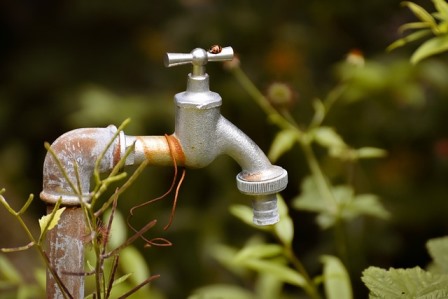Not only have South African's been struggling with high levels of load-shedding, as theft and vandalism continues to rise, Rand Water has confirmed that the ‘water outage’ in Ekurhuleni affecting millions of households and leaving residents without water for days on end, was as a result of strike action, theft and sabotage by Rand Water employees.
So, will this latest water disaster deter us gardeners? I say "NO WAY!" I am determined to continue gardening and growing my home-grown veggies and herbs no matter what!
Most of us have ensured that we have the basics in place to survive load shedding, like a gas bottle or two, lots of candles, torches, and recharge bulbs etc. And, if you are lucky enough to have solar power or a generator this makes life a lot easier. However, if you are without water, even for a couple of days, it’s another beast altogether! If you can’t afford a water tank, large garbage bins with sealable lids are fantastic to store rain or tap water in to use in emergencies for cleaning and washing dishes, and most importantly to flush toilets. Water bins can also help to save some thirsty plants.
Storing drinking water for emergencies is also no longer an option, and luckily purified or tap water is easily saved in whatever containers you may have on hand. Even old plastic bottles can be recycled to store tap water in for cleaning and washing purposes. We have all learnt that just having a few simple backup plans in place for an emergency, makes an enormous difference to our families wellbeing.
In SA we are used to gardening through extended periods of drought and the "water-wise" trend will never go out of fashion. But did you know that many edible crops can also be grown successfully with very little water, and there are many tried and tested methods of doing so? At a later stage I will delve more deeply into the various methods used, as well as other "survival" gardening skills, for tough times.
For example, in my recent research I was fascinated by the dry farming method which is widely practiced by farmers in the United States, the Middle East and in other grain growing regions such as the steppes of Eurasia and Argentina. Dryland farming was introduced to southern Russia and Ukraine by Ukrainian Mennonites, making the region the breadbasket of Europe. In Australia, it is widely practiced in all states but the Northern Territory.
I can see how these principles can be incorporated, to a degree, in ordinary gardening practices. The dry farming method is an environmentally sound practice that is not new but actually centuries old, originating in the Mediterranean where this farming technique is still being used today for growing grapes and olives, to produce some of the finest and most expensive wines and oils in the world.
This method is ideal for regions with a Mediterranean type climate with winter rainfall and dry summers, and it also works very well for fruit trees, tomatoes, melons, winter squash, grains, and several other deep-rooted food crops, all of which are trained to access retained subsurface water from the winter rainfall, instead of relying upon irrigation during the dry summer months.
Tomatoes must be top of the list for all gardeners wanting to grow vegetables and you may be surprised to know that in Northern California there is a method of growing tomatoes called "dry farmed tomatoes" which are grown with little or no supplemental water. The resulting tomato crops are usually smaller and lower in yield, but are sought-after and fetch a premium price because they are reputed to have a remarkably intense and delicious flavour. Farmers will tell you that a little drought stress actually deepens the flavours of ripening tomatoes, melons, and other garden crops.
Click here to see Google images of dry farmed tomatoes
Like our winter rainfall regions, California has a Mediterranean type climate, where winter rains saturate the soil, and the summers are dry. This is the ideal climate for the dry-farmed technique, and the native clay soil that makes up much of Contra Costa County and the Bay Area is ideal because it retains water.
Sandy soil, such as that in raised beds, dries out too quickly. However even if your soil is sandy, it can be enriched to hold more moisture, and even if the crops do need more water than those growing on clay soils, they can still survive with a lot less water than you would imagine.
I will continue to look for gardening techniques to keep our gardens healthy and productive when water is in short supply, and even if it’s not, these practices can be used to save you money by reducing the amount of water we give our plants. I hope you remain determined to never give up on your garden, your joy.




